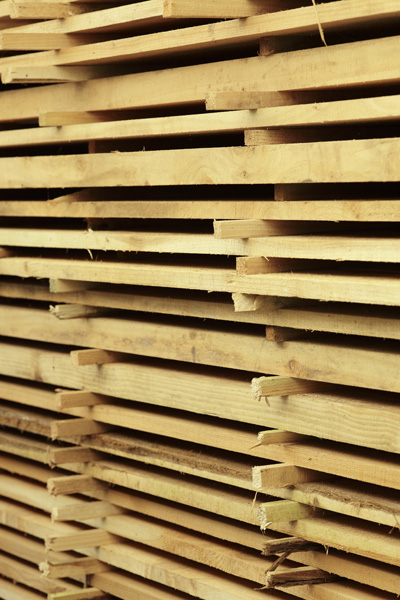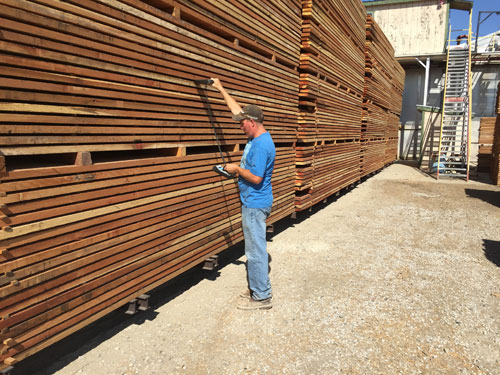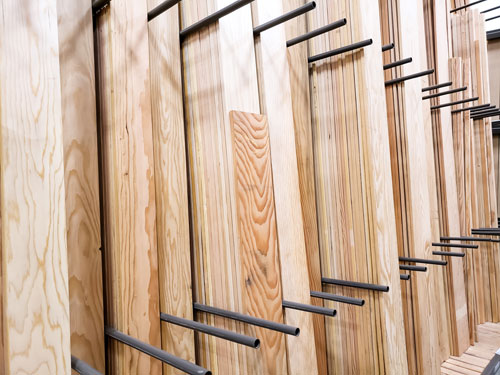Storing Lumber and Wood Components
Want to know how to store lumber and wood components, including valuable wood furniture? If so, you’ve come to the right place. But, no discussion about storing lumber and wood components would be complete without briefly reviewing the difference between unseasoned (green) wood and seasoned wood.
Unseasoned Wood
Unseasoned or green wood is wood that has been freshly sawn from a log. It has a very high moisture content compared to seasoned wood. While this moisture will eventually evaporate by itself, a dry kiln is usually used to speed up the process.
Seasoned Wood
Seasoned wood is wood that has been either kiln-dried or air-dried. It has a much lower moisture content than green wood.
Because wood is hygroscopic – that is, it loses or gains moisture depending on the relative humidity (RH) of its environment – it’s critical that seasoned wood or lumber, dimensioned wood components, or finished pieces of furniture be stored in conditions similar to those where they will be finally used. Otherwise, unwanted shrinkage or expansion may occur from losing or gaining moisture.
For a more in-depth discussion about what this means we strongly encourage you to read Acceptable Moisture Levels in Wood – Knowing the Moisture Content. It contains valuable background information and includes a fairly in-depth, but still easy-to-read discussion about the equilibrium moisture content (EMC) of wood and how it relates to RH. It will definitely help you better understand this article’s advice. It also contains information on how to use a moisture meter, a must-have tool for anyone who works with wood.
Now let’s talk about lumber storage…
Where to Store Lumber
Storing Unseasoned Lumber
Kiln and Indoor Drying
 Freshly sawn wood is full of moisture and while it will evaporate over time, a special kiln is usually used to accelerate the process. Much of the wood for sale on the market has been kiln-dried to reduce its moisture content.
Freshly sawn wood is full of moisture and while it will evaporate over time, a special kiln is usually used to accelerate the process. Much of the wood for sale on the market has been kiln-dried to reduce its moisture content.
However, it’s also possible to season wood indoors, but without using a kiln. Here’s how you do that…
Stack the wood horizontally with stickers in a warm, dry, indoor environment. (Stickers are small pieces of dry wood — usually around 1” x 1” — that are placed between the layers of lumber in order to allow air to circulate.) The stickers must be evenly spaced, lined up vertically (very important if you don’t want wavy lumber), and no more than 16” apart. Proper spacing is very important because unseasoned wood is pliable and will easily bend if it isn’t supported.
A few words about air-drying lumber outdoors…
Usually wood needs to be stored indoors if you want it to dry. This is because most climates are simply too humid and if you store the wood outside it won’t dry properly. This is especially true if you’re going to use the wood for furniture or anything else that’s going to be used indoors, such as wood flooring.
You might be able to get away with storing construction-type wood materials outside for a while but most climates require that they are covered. However, for the most part, wood is seasoned by either placing it in a kiln or in a warm, low-humidity indoor environment.
Storing Seasoned Lumber
If you have wood that’s at its desired moisture content, store it indoors. Preferably, in the location where it will be finally used. Make sure you control moisture in the storage area so the wood remains at its desired moisture content.
Horizontally or Vertically? What Is the Best Way to Store Lumber?
 Unseasoned wood should always be stored horizontally. However, once wood is dry (seasoned), how you store it doesn’t matter as much. But, provided you have space, it’s best to store both types of lumber horizontally. Of course, that’s in an ideal world. If you don’t have space, that’s OK. It’s possible to store dried lumber vertically without any problems. We’ll go over both storage solutions.
Unseasoned wood should always be stored horizontally. However, once wood is dry (seasoned), how you store it doesn’t matter as much. But, provided you have space, it’s best to store both types of lumber horizontally. Of course, that’s in an ideal world. If you don’t have space, that’s OK. It’s possible to store dried lumber vertically without any problems. We’ll go over both storage solutions.
Storing Lumber Horizontally
How to Store Lumber Horizontally
If you’re storing unseasoned lumber inside or outside (outside isn’t recommended unless you live in a dry environment) to air dry it you’ll need to use stickers to allow some air to flow through the wood so it doesn’t warp or decay. Make sure the stickers are dry and of the same thickness. Place them at the ends of the rows and every 12-16 inches. Make sure you line them up vertically as well. See the above discussion about storing and drying lumber.

Storing seasoned lumber horizontally indoors
If you have lumber you want to store indoors horizontally, make sure it’s well supported. Place support boards every 16-18 inches to keep the wood from bowing.
If you’re storing seasoned wood indoors you don’t need to use stickers. Too much weight can also cause the wood to bend. With lumber prices up and down you don’t want to waste any lumber.
Storing Lumber Vertically
 If you don’t have the space to store seasoned wood indoors horizontally, you can store it vertically. (As we’ve already discussed, you’ll need to store unseasoned (i.e. green) lumber horizontally until you dry it down to the desired moisture content.)
If you don’t have the space to store seasoned wood indoors horizontally, you can store it vertically. (As we’ve already discussed, you’ll need to store unseasoned (i.e. green) lumber horizontally until you dry it down to the desired moisture content.)
How to Store Lumber Vertically
If you’re going to store seasoned wood vertically indoors, be sure to use a storage system that’s raised off the ground so air can flow underneath. Concrete floors might look dry, but moisture can rise up from them and get into your wood if you’re not careful. Wood will warp and even rot if it’s exposed to moisture for too long.
The storage system should have support at both the top and the bottom to prevent bowing. If you have a lot of smaller pieces you can put them in a lumber cart. You’ll find information, images, and free plans online for how to build one.
While it’s perfectly fine to store seasoned wood vertically, when it comes to long-term storage, horizontal is probably best. This also applies for seasoned wood that’s less than ½-inch thin.
Remember: Storing lumber vertically is for seasoned wood only. Never stack unseasoned wood vertically or you’ll get bowing.
Treated Lumber
Treated lumber is wood that has been treated with preservatives in order to prolong its lifespan. It can be stored in the same way as untreated wood.

Free Download – 6 Reasons Your Wood Project Failed
How to Store Wood Components Such As Furniture
Storing wood furniture and components isn’t that difficult. You simply need to follow a few rules to ensure your valuables don’t get damaged while they’re being stored:
- If possible, use a storage unit with climate control. Wood can crack if it gets too dry and warp if there’s too much moisture in the air. High humidity can also cause mold and mildew to form on wood. Therefore, you’ll ideally want a storage space where you can control both the temperature and the humidity.
- Store wood components and furniture off the ground. Cinder blocks or wooden pallets are an easy way to lift your wood valuables off the ground and away from damp floors and possible water damage. Getting your wood off the ground also gets air circulating around it. If you can’t get it off the ground, place heavy plastic sheeting under it. This will protect it from moisture.
- Don’t leave anything stored inside the furniture. Make sure all drawers and cabinets are empty.
- Cover with something breathable like cotton. Don’t use plastic because it can create condensation and cause the wood to swell. A cotton sheet will keep out the dust while allowing the wood to breathe.
- Apply a bit of wax or polish before storing. It never hurts to give your wood components or furniture a good moisturizing prior to storage. It will help prevent cracking which can be caused by environmental changes.
- Don’t stack anything on top of wood furniture. If you want to avoid damaging your valuable wood furniture while it’s in storage don’t place anything on top of it, even lightweight boxes.
Storing lumber and wood components isn’t difficult. You simply need to follow a few rules and make sure you understand how wood interacts with moisture in the environment. If you haven’t already read the article we mentioned above, we recommend that you read it now. It’s a great primer for understanding moisture content in wood and will help you better understand the advice in this article.
As Sales Manager for Wagner Meters, Ron has more than 35 years of experience with instrumentation and measurement systems in different industries. In previous positions, he has served as Regional Sales Manager, Product and Projects Manager, and Sales Manager for manufacturers involved in measurement instrumentation.
Related Posts via Taxonomies
Last updated on October 21st, 2021




I would like to ask if i can add multiple stickers based on the length of the timber im storing. Or is that how it works and i haven’t read the whole thing correctly?
Jeramy, as the old saying goes, ‘a picture is worth a thousand words.’ Please click on this link that I found when I was searching for a photo of stickered lumber (timber): https://www.woodshopnews.com/features/a-simple-approach-to-drying-lumber
As a handyman business owner who stores wood. I found this very informative, thankyou for this article.